Home>Technology>Security & Surveillance>How To Break A Door Lock With A Screwdriver


Security & Surveillance
How To Break A Door Lock With A Screwdriver
Modified: May 6, 2024
Learn how to break a door lock with a screwdriver and enhance your security and surveillance skills with our step-by-step guide. Master the art of door lock manipulation for improved home security.
(Many of the links in this article redirect to a specific reviewed product. Your purchase of these products through affiliate links helps to generate commission for Storables.com, at no extra cost. Learn more)
Introduction
Welcome to the world of security and surveillance, where we unravel the mysteries of door locks and the art of bypassing them using a simple yet effective tool – the screwdriver. In this comprehensive guide, we will delve into the inner workings of door locks, explore the nuances of selecting the right screwdriver, and master the technique of breaking a door lock with precision and finesse.
Whether you find yourself locked out of your own home or you're simply curious about the vulnerabilities of door locks, this article will equip you with the knowledge and skills to tackle such situations. While the primary intent is to empower individuals with the ability to address lock-related predicaments, it's crucial to emphasize the ethical considerations surrounding these techniques. Understanding the mechanisms of door locks and the tools used to manipulate them can also serve as a means of bolstering security measures and safeguarding against potential threats.
So, buckle up and prepare to embark on a journey through the inner workings of door locks, the art of selecting the right screwdriver, and the strategic approach to breaking a door lock with a screwdriver. By the end of this guide, you will have gained a newfound understanding of door security and acquired a valuable skill set that may come in handy when least expected. Let's dive in!
Key Takeaways:
- Breaking a door lock with a screwdriver requires understanding the lock’s vulnerabilities and using the right tool. It’s a skill that demands precision and patience, and should only be used ethically and legally.
- By mastering the art of bypassing door locks, individuals can gain problem-solving skills and a deeper understanding of security. It’s important to approach this knowledge with responsibility and integrity.
Understanding Door Locks
Before we delve into the intricacies of bypassing a door lock with a screwdriver, it’s essential to comprehend the fundamental mechanisms of common door locks. The most prevalent types of door locks include pin tumbler locks, wafer tumbler locks, and disc tumbler locks, each with its unique design and vulnerabilities.
Pin tumbler locks, commonly found in residential settings, consist of a series of spring-loaded pins of varying lengths that prevent the lock from turning without the correct key. Wafer tumbler locks, often used in filing cabinets and automobile doors, feature flat wafers instead of pins. Disc tumbler locks, prevalent in vending machines and some automobiles, employ rotating discs as the primary locking mechanism.
Understanding the inner workings of these locks enables individuals to identify their weaknesses and potential points of manipulation. For instance, exploiting the gap between the lock cylinder and the door frame is a common method for bypassing pin tumbler locks. Similarly, wafer tumbler locks are susceptible to manipulation by applying rotational pressure to the lock cylinder using a screwdriver.
By familiarizing ourselves with the vulnerabilities of these lock types, we gain insight into the strategic application of tools such as screwdrivers to circumvent their security features. This knowledge forms the foundation for effectively bypassing door locks, as we will explore in the subsequent sections.
Now that we’ve established a foundational understanding of door lock mechanisms, let’s proceed to the next crucial aspect of our endeavor: selecting the right screwdriver for the task at hand.
Choosing the Right Screwdriver
When it comes to breaking a door lock with a screwdriver, the selection of the right tool is paramount. A screwdriver’s effectiveness in bypassing a lock hinges on several key factors, including its size, shape, and material composition. Let’s explore the essential considerations for choosing the optimal screwdriver for this purpose.
Size and Shape
The size and shape of the screwdriver play a pivotal role in its ability to manipulate a door lock. For pin tumbler locks, a flathead screwdriver with a narrow, tapered tip is often preferred. This design allows for precise maneuvering within the tight confines of the lock mechanism, facilitating the application of rotational force to the lock cylinder.
Alternatively, wafer tumbler locks may necessitate the use of a screwdriver with a broader, flat tip to engage with the wafers effectively. Understanding the specific requirements of the target lock is crucial in determining the most suitable screwdriver profile for the task at hand.
Material Composition
The durability and resilience of the screwdriver’s material are essential considerations. Opting for a high-quality, hardened steel screwdriver enhances its effectiveness and longevity when used for lock manipulation. The robust construction of the screwdriver minimizes the risk of breakage or deformation during the application of torque, ensuring a reliable and consistent performance.
Read more: How To Break Into A Sliding Glass Door
Handle Design
Beyond the physical attributes of the screwdriver tip, the design of the handle warrants attention. A comfortable, ergonomic handle promotes precise control and minimizes hand fatigue during prolonged use. Additionally, a non-slip grip is advantageous, especially when applying rotational force to the screwdriver while manipulating the lock mechanism.
By meticulously assessing these factors, individuals can make an informed decision when selecting the most suitable screwdriver for bypassing a door lock. With the right tool in hand, we are poised to explore the strategic approach to breaking a door lock using a screwdriver, a skill that demands precision and finesse.
Breaking a Door Lock with a Screwdriver
Now that we’ve gained a comprehensive understanding of door lock mechanisms and selected the optimal screwdriver for the task, it’s time to delve into the strategic process of breaking a door lock using this versatile tool. While the notion of bypassing a lock may evoke images of forceful entry, it’s crucial to approach this technique with precision and finesse, leveraging the inherent vulnerabilities of the lock to achieve our objective.
Assessment and Preparation
Prior to commencing the lock-breaking process, a thorough assessment of the target lock is essential. Identifying the type of lock and understanding its vulnerabilities enable us to devise a strategic plan for manipulation. Additionally, ensuring that the chosen screwdriver aligns with the lock’s requirements is paramount.
Application of Rotational Force
For pin tumbler locks, the application of rotational force to the lock cylinder is a fundamental step in the bypassing process. With the selected screwdriver inserted into the keyway, gentle but deliberate pressure is applied to initiate the manipulation of the lock components. This technique capitalizes on the inherent design flaws of pin tumbler locks, allowing for the gradual alignment of the internal pins and the eventual rotation of the lock cylinder.
Similarly, wafer tumbler locks require a nuanced approach, with the screwdriver being used to engage and manipulate the individual wafers within the lock mechanism. By strategically applying pressure and leveraging the flat tip of the screwdriver, the wafers can be maneuvered to facilitate the rotation of the lock cylinder, ultimately bypassing the locking mechanism.
Read more: How To Unlock Door With A Screwdriver
Precision and Patience
Throughout the process of breaking a door lock with a screwdriver, precision and patience are indispensable virtues. The delicate manipulation of the lock components demands a steady hand and a keen understanding of the lock’s behavior. Incremental adjustments and subtle movements of the screwdriver are often required to align the internal components and achieve the desired outcome.
It’s important to note that the techniques described herein are intended for educational purposes and should only be employed in ethical and legal contexts, such as addressing lock-related emergencies or bolstering security measures within a responsible framework.
By mastering the strategic approach to breaking a door lock with a screwdriver, individuals can gain a profound appreciation for the intricacies of lock manipulation while honing their problem-solving skills in the realm of security and surveillance.
Conclusion
As we draw the curtains on our exploration of breaking a door lock with a screwdriver, it’s imperative to reflect on the knowledge and skills we’ve acquired throughout this journey. From understanding the inner workings of door locks to selecting the optimal screwdriver and mastering the strategic approach to bypassing locks, we’ve delved into a realm where security and ingenuity intersect.
While the techniques discussed herein encompass the art of circumventing door locks, it’s essential to underscore the ethical considerations that accompany this knowledge. The ability to bypass locks should be wielded responsibly and with the utmost integrity, guided by a profound respect for security and privacy. Whether it’s addressing lock-related emergencies or bolstering security measures, the ethical application of these skills is paramount.
Moreover, the insights gleaned from this guide extend beyond the realm of lock manipulation. They underscore the significance of understanding the vulnerabilities inherent in security systems, thereby empowering individuals to fortify their defenses and preempt potential threats. By fostering a deeper comprehension of security mechanisms, we cultivate a proactive mindset that transcends the realm of door locks, permeating various facets of personal and collective security.
As we part ways, armed with a newfound understanding of door lock manipulation and the strategic use of a screwdriver, let’s carry forth this knowledge with a sense of responsibility and ethical stewardship. Whether it’s unraveling the mysteries of security or honing our problem-solving skills, the journey we’ve embarked upon serves as a testament to the intersection of knowledge, ingenuity, and ethical conduct.
So, as you navigate the realms of security and surveillance, may this guide serve as a beacon of insight and responsibility, guiding your endeavors with wisdom and discernment. Remember, with great knowledge comes great responsibility, and the ethical application of our skills defines the true measure of our character.
Now that you've mastered the technique of breaking a door lock with a screwdriver, consider stepping up your overall home safety strategy. Our next guide delves into why robust home security systems are vital for protecting your property and loved ones. From deterring intruders to ensuring peace of mind, understanding these essentials could be a game-changer for your household's safety. Don't miss out on securing your sanctuary effectively!
Frequently Asked Questions about How To Break A Door Lock With A Screwdriver
Was this page helpful?
At Storables.com, we guarantee accurate and reliable information. Our content, validated by Expert Board Contributors, is crafted following stringent Editorial Policies. We're committed to providing you with well-researched, expert-backed insights for all your informational needs.














0 thoughts on “How To Break A Door Lock With A Screwdriver”